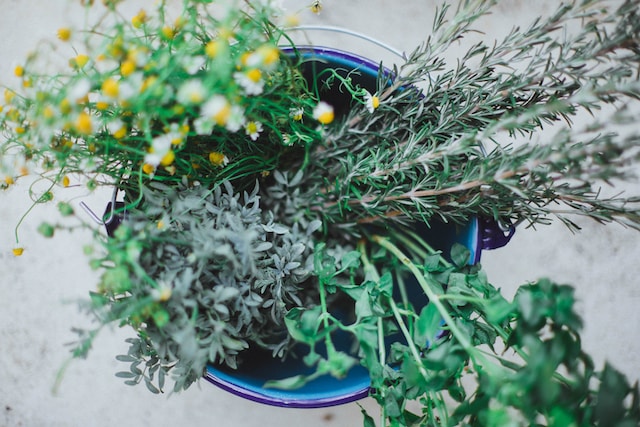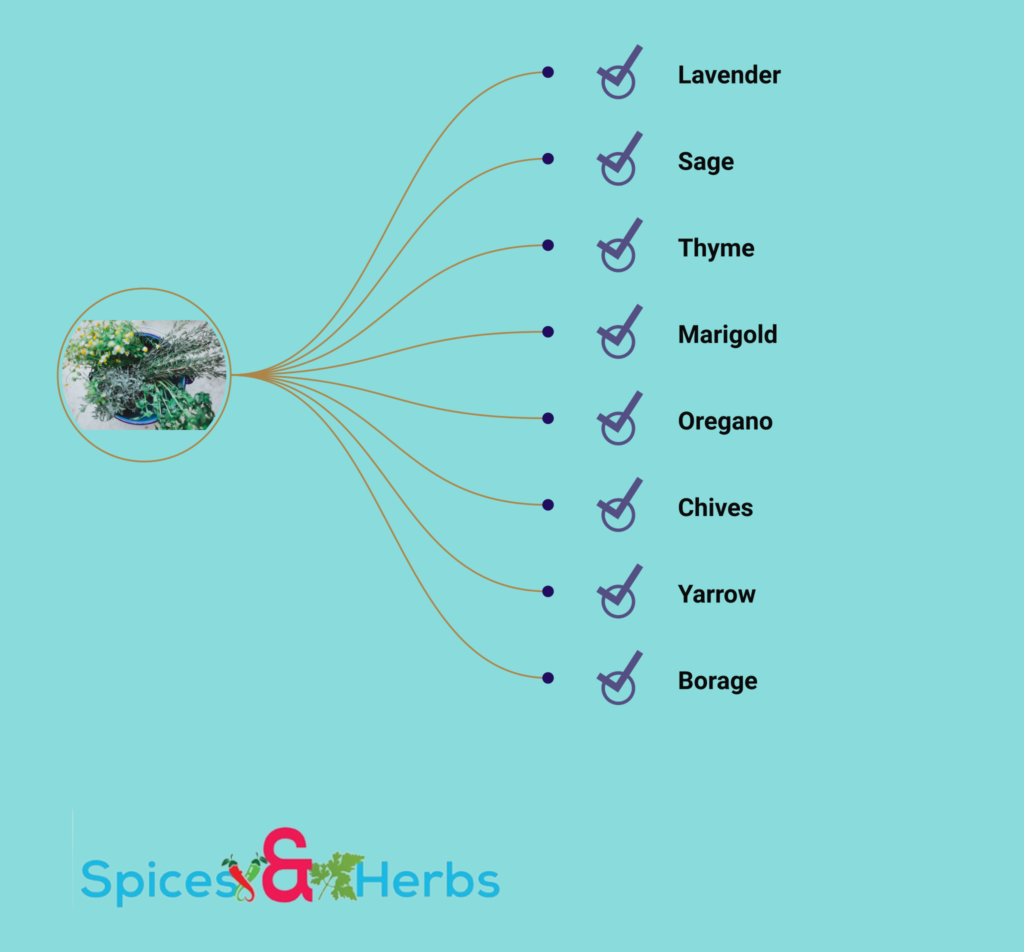Can you imagine a garden where plants work together in perfect harmony, creating a thriving ecosystem of beauty and productivity? In this blog, we will delve into the fascinating world of companion plants for rosemary.
Gardening is more than just a pastime; it’s an opportunity to witness the wonders of nature’s collaboration firsthand. By strategically pairing compatible plants, we can unlock a whole new level of gardening success. So without further ado, let’s dive in!
What Are Companion Plants?

Companion plants are basically buddies that are grown side by side in a garden because they actually help each other out. It’s like having a plant support system where they boost each other’s growth, health, and overall happiness. This gardening technique, known as companion planting, has been around for ages and revolves around the idea that certain plants are like the ultimate wingmen for others. They bring in the good bugs, shoo away the bad ones, give shade or a helping hand, make the soil more fertile, or even keep those pesky weeds in check. It’s like a beautiful partnership where everyone benefits and the garden thrives!
Why Does Rosemary Need Companion Plants?
Rosemary can benefit from companion plants for several reasons:
🟩 Pest control
Rosemary has natural insect-repelling properties, but companion plants can enhance this effect. Some companion plants have scents or compounds that repel specific pests, helping to protect the rosemary from insect infestations. For example, planting rosemary with cabbage or carrots can help deter pests like cabbage moths and carrot flies.
🟩 Beneficial insect attraction
Certain companion plants, such as marigolds and daisies, attract beneficial insects like ladybugs, lacewings, and hoverflies. These insects prey on garden pests like aphids, caterpillars, and mites, which can harm the rosemary plant. By attracting these beneficial insects, companion plants help maintain a natural balance in the garden ecosystem.
🟩 Microclimate regulation
Some companion plants can provide shade and create a more favorable microclimate for rosemary. Taller plants like sunflowers or bushy plants like lavender can help shield the rosemary from excessive heat and direct sunlight. This regulation of temperature and moisture levels can promote healthier growth and protect the rosemary from stress.
🟩 Soil improvement
Certain companion plants, particularly legumes like clover or beans, have nitrogen-fixing capabilities. They take nitrogen from the air and convert it into a form that can be absorbed by plants. Planting these companions near rosemary enriches the soil with nitrogen, which is an essential nutrient for plant growth. Improved soil fertility benefits the rosemary plant and supports its overall health.
🟩 Aesthetic appeal
Companion plants can enhance the visual appeal of a garden by providing contrasting colors, textures, and heights. Pairing rosemary with visually appealing companions can create a more attractive and visually diverse garden landscape.
It is important to note that not all plants make good companions for rosemary. Some plants may compete for resources, have different watering or sunlight requirements, or be susceptible to the same diseases. Therefore, it is essential to research and choose compatible companion plants that will benefit both the rosemary and the overall garden ecosystem.
Considerations When Choosing Companion Plants for Rosemary

When choosing companion plants for rosemary, there are several considerations to keep in mind. Companion planting involves selecting plants that have mutually beneficial effects when grown together. Here are some factors to consider:
🟦 Soil and watering requirements
Rosemary prefers well-drained soil and doesn’t tolerate excessive moisture. Choose companion plants with similar soil and watering needs to ensure they thrive together. Suitable companions include thyme, sage, lavender, oregano, and marigolds, as they all prefer well-drained soil and moderate watering.
🟦 Sunlight requirements
Rosemary is a sun-loving plant that requires full sun for optimal growth. Select companion plants that can tolerate or thrive in similar light conditions. Good choices for full sun conditions include thyme, lavender, sage, marigolds, and oregano.
🟦 Pest and disease resistance
Some companion plants can help repel pests or attract beneficial insects that can protect rosemary from common pests. Planting marigolds or alliums (such as onions or chives) nearby can deter aphids and other pests. Nasturtiums are also beneficial as they attract predatory insects that feed on pests.
🟦 Growth habits and height
Consider the growth habit and height of the companion plants to ensure they don’t overshadow or shade the rosemary excessively. Avoid planting tall or spreading plants that could compete for resources or hinder rosemary growth. Good companion plants with similar growth habits include thyme, lavender, sage, oregano, and marigolds, which all have compact growth forms.
🟦 Complementary aromas
Rosemary has a strong aroma, and choosing companion plants with complementary scents can create a pleasant sensory experience. Lavender, thyme, sage, or other herbs can be good choices for their aromatic qualities. Additionally, the scent of marigolds can help deter pests.
🟦 Flowering period
Select companion plants that bloom at different times than rosemary to ensure a continuous display of flowers throughout the growing season. This can attract pollinators and add visual interest to the garden. Some examples of plants with different flowering periods include lavender, marigolds, and annual flowers like calendula or zinnias.
🟦 Culinary pairings
Consider selecting companion plants that have culinary uses and can be harvested alongside rosemary. Planting basil, oregano, or tomatoes near rosemary can provide a convenient herb garden for cooking. Other suitable culinary companions include thyme, sage, and parsley.
🟦 Space and spacing
Take into account the available space and the spread of companion plants. Ensure they won’t overcrowd or compete with rosemary for resources like sunlight, water, and nutrients. Provide enough space between plants to allow for airflow and prevent overcrowding.
Top Companion Plants for Rosemary
When it comes to companion planting, certain plants can benefit rosemary by attracting beneficial insects, deterring pests, and providing a visually appealing and harmonious garden. Here are some top companion plants for rosemary:

🟧 Lavender
Lavender and rosemary share similar growing conditions and aesthetics, making them an ideal pairing. Lavender’s aromatic flowers attract pollinators like bees and butterflies while also repelling pests such as moths and fleas. The combination of lavender and rosemary creates a visually stunning herb garden with complementary scents.
🟧 Sage
Sage is another Mediterranean herb that complements rosemary both in terms of flavor and appearance. Planting sage alongside rosemary not only enhances the fragrance of the garden but also provides natural pest control. Sage has a strong aroma that deters pests like cabbage moths and carrot flies, making it an excellent companion for rosemary.
🟧 Thyme
Thyme is a versatile herb that pairs well with rosemary both in culinary applications and in the garden. These two herbs share similar care requirements, including full sun and well-drained soil. Thyme attracts beneficial insects such as bees and hoverflies, which help pollinate the garden and control pests like cabbage worms.
🟧 Marigold
Marigolds are a popular companion plant for various herbs, including rosemary. These vibrant flowers not only add a splash of color to the garden but also serve as natural pest repellents. Marigolds emit a strong scent that repels nematodes, aphids, and other harmful insects. Planting marigolds near rosemary can help protect the herb from pest infestations.
🟧 Oregano
Oregano is a close relative of rosemary and makes an excellent companion plant. These two herbs have similar cultural requirements, such as well-drained soil and ample sunlight. Combining oregano with rosemary creates an attractive herb garden with complementary flavors and aromas. Oregano also has pest-repellent properties and can help deter pests like cabbage worms and aphids.
🟧 Chives
Chives are versatile herb that pairs well with rosemary and offers multiple benefits. These slender green shoots produce attractive purple flowers and have a strong onion-like scent. Chives are known for their ability to repel pests, particularly aphids. Planting chives near rosemary can help protect the herb from aphid infestations while adding visual interest to the garden.
🟧 Yarrow
Yarrow is a perennial flower that serves as an excellent companion plant for rosemary. Its clusters of small, aromatic flowers attract beneficial insects such as ladybugs, lacewings, and parasitic wasps. These insects help control aphids, mites, and other pests that can harm rosemary. Yarrow also adds a beautiful touch to the garden with its variety of flower colors, including white, yellow, pink, and red.
🟧 Borage
Borage is a herbaceous plant with attractive blue flowers that make it an excellent companion for rosemary. The vibrant flowers of borage attract pollinators, including bees and butterflies, which help in the pollination of nearby plants. Additionally, borage has pest-repellent properties and can deter harmful insects like hornworms and cabbage worms, providing natural pest control for rosemary.
When planning companion planting, consider the specific growing requirements and regional suitability of these plants to ensure they thrive together and support each other’s growth in the garden.
Companion Planting Recommendations for Rosemary
To properly plant companion plants with rosemary, follow these guidelines:
🟪 Select appropriate companion plants
Choose plants that have similar growing requirements to rosemary in terms of sunlight, soil type, and moisture. Consider the specific benefits you want from the companions, such as pest deterrence, flavor enhancement, or complementary aesthetics. Refer to the list of recommended companion plants mentioned earlier.
🟪 Plan your garden layout
Take into account the mature size and growth habits of both the rosemary and its companion plants. Consider factors such as height, spread, and overall shape. Place taller plants towards the back of the bed or in the center if you’re creating a circular garden. Ensure that each plant has enough space to grow without overcrowding or shading out others.
🟪 Prepare the soil
Rosemary thrives in well-drained soil. Prepare the planting area by removing any weeds or vegetation. Loosen the soil using a garden fork or tiller, incorporating organic matter such as compost or well-rotted manure to improve soil structure and fertility. Rosemary prefers slightly alkaline soil, so you may need to adjust the pH by adding lime if your soil is acidic.
🟪 Planting distances
Consider the mature size of both the rosemary and the companion plants when determining planting distances. Provide enough space between plants to ensure they receive adequate sunlight, air circulation, and access to nutrients. Typically, aim for a spacing of about 12-18 inches (30-45 cm) between rosemary plants and their companions.
🟪 Watering
After planting, water the plants thoroughly to help settle the soil and establish root systems. Provide regular watering as needed, ensuring the soil doesn’t become waterlogged. Once established, rosemary is drought-tolerant and prefers drier soil conditions. However, be mindful of the water needs of the companion plants, as they may have different requirements.
🟪 Mulching
Apply a layer of organic mulch, such as straw or wood chips, around the base of the plants. Mulching helps retain moisture, suppresses weed growth, and regulates soil temperature. Keep the mulch a few inches away from the stems of the plants to prevent excessive moisture buildup and potential rotting.
🟪 Maintenance
Monitor the plants regularly for signs of pests, diseases, or nutrient deficiencies. Prune and trim the rosemary and its companions as needed to maintain their shape and size. Remove any damaged or diseased foliage promptly to prevent the spread of diseases. Regularly weed the planting area to minimize competition for resources.
🟪 Harvesting
Enjoy the benefits of your companion planting by harvesting both the rosemary and the companion plants when they are at their peak. Harvesting herbs often promotes continued growth and keeps the plants productive. For culinary herbs like rosemary, snip the stems just above a set of leaves to encourage branching and new growth.
By following these steps, you can ensure that your companion plants thrive alongside rosemary, creating an attractive and beneficial garden setting. Remember to adapt these guidelines based on your specific growing conditions and the requirements of the chosen companion plants.
How Many Companion Plants Must a Rosemary Have?
When it comes to companion planting with rosemary, there isn’t a set number of plants you must have. It’s more about personal preference and the specific benefits you’re looking to achieve. Some gardeners opt for a single companion plant, while others enjoy creating a mixed herb garden with several companions.
Including even one companion plant can bring advantages to your rosemary. For instance, planting a marigold or lavender nearby can help ward off pests and attract beneficial insects. These plants can create a beautiful and functional garden space. However, if you have the space and inclination, you can definitely add multiple companion plants to enhance the overall dynamics.
Final Words
In conclusion, companion planting is a gardening technique that brings together the power of synergy and mutual support among different plant species. By strategically pairing compatible plants, we can create a thriving ecosystem in our gardens and maximize their productivity while minimizing the need for chemical pesticides and fertilizers.
So, go ahead and experiment with companion planting techniques in your garden, and let the magic of rosemary and its companions unfold. Happy gardening!
To know more about the uses of rosemary, just click here!
